#demoride
I rolled on the throttle. I rocked backward. The rear shock compressed. And the front wheel lifted off the tarmac.

I’m a minimalist. I own seven pairs of underwear. I own 3 pairs of shoes - black boots, brown boots, and running shoes. I own one motorcycle. And most importantly, I don’town a car.
In my quest to downsize my possessions, I asked myself:
Do I really need a shelf full of books? Not when I can borrow them from the library.
Do I really have to collect vinyls? Not when I can Spotify the record.
Do I really need a second motorcycle? Maybe we should talk about this one…
When you undertake this lifestyle, you realize that simplicity doesn’t always lend itself to functionality. You learn that you better do laundry every week or you’re going commando on Monday. You learn to dress up your boots for the work week and dress them down for weekend hikes. And you learn that you’re shit out of luck when your motorcycle gets a flat.
If that last example seems oddly specific, that’s because I recently picked up a nail in my rear tire and had to take a sick day. I rely on one vehicle to get me to and from work, so I don’t have a plan B if anything goes wrong. They say the best ability is availability and I can’t expect the Harley to be 100% one-hundred percent of the time. So maybe a second motorcycle wouldn’t be such a bad idea, right?
I know what you’re saying, “why not just buy a car?” But I’m sorry faithful reader, that sounds far too practical and honestly isn’t an option for me. I enjoy not owning a car and I will do my best to keep it that way.
With that established, I should note that I want my second motorcycle to be off-road capable? I want to take on challenging, new terrain. I want to slide the back wheel out. I want to hit the whoops. I want to ride where I won’t get obliterated by a 2-ton cage on four wheels.
With that in mind, my search invariably led me to dual sports. Though I’d prefer a dedicated dirt bike, I’d also prefer to NOT own a pickup truck. How else would I get to the trails if I didn’t own an expensive toy (in the form of a truck) to cart my other expensive toy (in the form of a dirt bike) there? How could I keep my possessions to a minimum while justifying the purchase as a “necessary, and specialized” tool (wink, wink)?
Cue Zero’s light, dual sport, electric motorcycle, the FX.
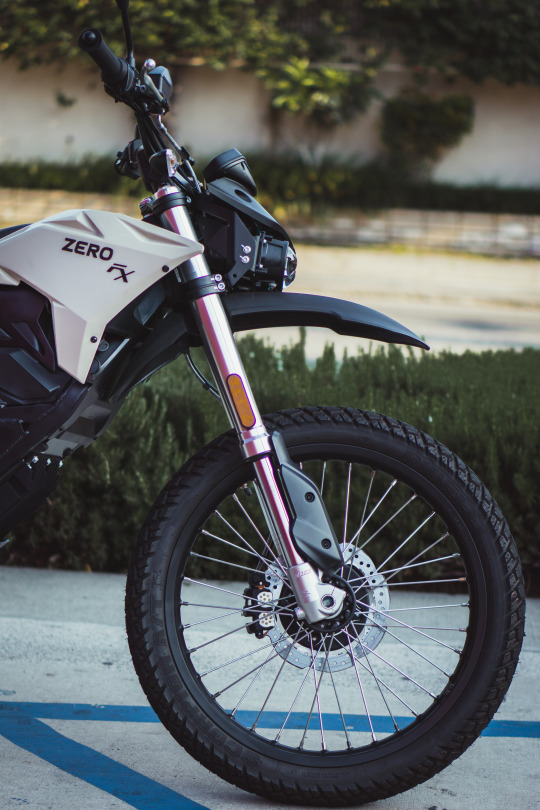
At 289 lbs, the FX touts an astounding 46 horsepower and 78 ft-lb of torque! Versus Honda and Husqvarna’s 450cc dual sports, that’s a powerful package that was just begging to be ridden. So when I swung a leg over the FX, it’s safe to say that I was giddy as an alcoholic at an open bar.
At just under 35″, the Zero’s seat height isn’t for the vertically challenged. With 8.6″ of travel up front and 8.9″ in the rear, I had to use all of my 5′10″ frame to fit the bike. While stationary, I stabilized the bike on the tips of my toes, but anyone sub-5′8″ would probably need to favor one foot at stop lights, using their leg as a human kickstand of sorts. Compared to the low slung seat of my Harley and the intermediate height of the Naked bikes I’ve ridden recently, the FX felt like straddling a donkey without stirrups.
With my toes brushing the concrete, I couldn’t help but bounce on the rear suspension. Surprisingly, the monoshock compressed quite easily, filling me with hope for undulating terrain, yet filling me with dread for twisting roads. It’s safe to say that my past experience with Yamaha’s FZ-07 left me with a residual distrust of mushy springs.

Once the rest of the group mounted up, we set out for the Hollywood Hills. Zipping along Fairfax Ave, our e-motors buzzed like a pack of RC cars, the audible whir increasing along with our speed. If there’s anything consistent across the Zero models that I’ve tested (FX & SR/F), it’s the sophistication of the throttle mapping. Without the modulation of a clutch, you would assume that the power would engage the back wheel instantaneously, but the gradual roll on aids the most ham-fisted riders and ramps up with exponential velocity as you twist your wrist.
While the FX gains speed without effort, it also holds low speeds with nuance and finesse. Squeaking past Hollywood traffic isn’t an easy feat for many a bike, but Zero’s dual sport pulls it off with a controlled low-speed mapping and steering.

The narrow frame squeezes through the smallest of spaces and its height allows the handlebars to easily float over side view mirrors. With a combination of weasel-like maneuverability and a range of 91 miles per charge, the FX challenges all other commuter candidates in the field.
As my group turned off Hollywood, leaving the urban landscape behind, I was pleased to see an empty street winding up a steep hill. That’s when the pace quickened. That’s when motor really stretched its legs. That’s when I could test out that suspect suspension.
We accelerated up the increasing incline, each rider inclined to increase the space between them and those following. We banked right. We banked left. And to my surprise, the “mushy” monoshock retained its rigidity in the corners, responding to my every input.

On my Harley, I depend on the weight of the bike to slow down my approach into an uphill corner, but on this featherweight, you barely lose any velocity. Despite my approaching speed, the bike easily negotiated each turn, relying on the combination of snappy handling and ride height/lean angle.
Though blasting through the corners is fun, speed is nothing without brakes, and the FX delivers in that department. Once we slowed to a stop, I peered down at the front rotor, floored by the fact that it only housed a single 240 mm rotor and a 4-piston caliper. The stiff, even braking left me perplexed. How could such a minimal package provide maximum performance?
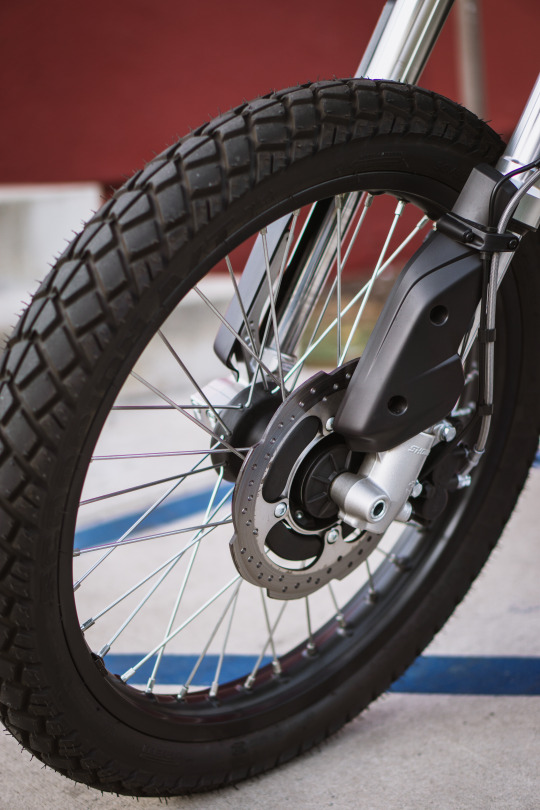
I could chalk it up to the light weight of the FX, but that would be an oversimplification because the J-Juan calipers that come equipped on all Zeros have only outperformed my expectations on the bikes I’ve tested.

Once the pack regrouped at a stop sign, we turned down a side street.
I rolled on the throttle. I rocked backward. The rear shock compressed. And the front wheel lifted off the tarmac.
Now, I can’t lie, I wanted to see if I could wheelie the FX. Lacking a clutch, Zero’s dual sport has to rely on horsepower alone to get that front wheel up, and I’d be lying if I said that I wasn’t curious if it could do it. But once I achieved my goal, I came to my senses and kept my lead wrist in check.
We soon descended the domestic labyrinth, bending the fleet of Zeros through the gentle curves of the Hollywood Hills neighborhood. Little did I know, a stop sign was waiting for me at the bottom of the hill.
I stabbed the front brake. I slammed on the rear pedal. I braced for the endo. I waited for the rear to break loose. But instead, the bike eased to a steady stop, the calipers progressively clamping down on the frisbee-sized rotors.

After that close call, I diagnosed the only shortfall with the FX, and it wasn’t the brakes, it wasn’t the handling, and it damn sure wasn’t the power. The sole complaint I had for the FX was the ergonomics.
While the bars are wide, while the riding posture is upright, the height of the footpegs leave your lower quarters cramped. At a level angle, the pegs force your feet into an acute angle with your shins. Having my knees bunched up, I found myself frequently dangling my right foot where it naturally wanted to rest, under the brake pedal. Not the safest of positions when you need to brake in an emergency.
But aside from the performance of the bike, you also have to take pragmatism into account. The biggest barriers for the FX - and most electric motorcycles - are price and range. With an MSRP over $10K, I’m not sure if I could justify purchasing a bike that only nets an hour and a half of ride time. I wouldn’t be able to undertake a long trip on the FX. I would be limited to a 45-mile riding radius or risk the possibility of not making it back home. Living in the city, I’m not sure if I could even make it to the dirt with that capacity (or lack thereof).
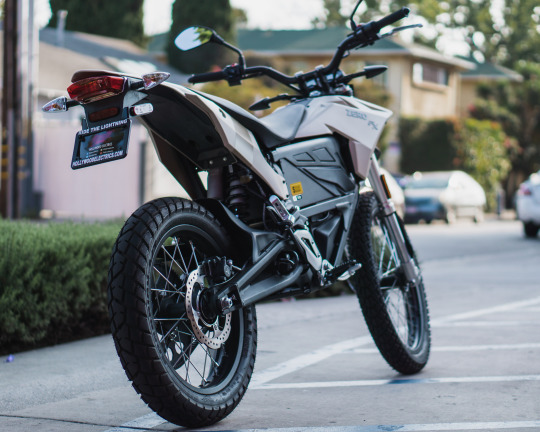
In order to get the most out of the FX, I would need to transport it to the nearest trail, and it doesn’t make much sense to pay for a $10K bike that would need a $20K truck for me to properly enjoy it. At a scant 91 miles per 9.7-hour charge, I realized that the best ability truly is availability. And I’ll take a Harley that’s 100% ninety percent of the time versus a Zero that is only 100% fifty percent of the time.
In time, the range of e-bikes will increase and the price will decrease, but for now, I’ll rely on my good ole Low Rider…and maybe take a few more sick days.
Size does matter, and in this case, smaller is better.
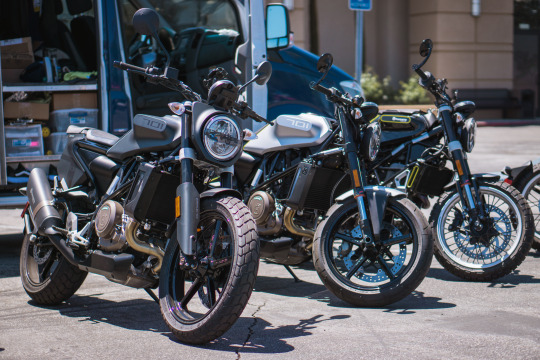
It’s no secret that Husqvarna’s dirt bikes and dual sports sell themselves. Touting a storied motocross/scramble history, it’s easy to see why the off-roaders are so popular with the public. On the other hand, the company hasn’t seen much success with its street-oriented lineup. With 2019s still occupying the showroom floor and the pressure of Q3 looming, Husky recently visited Azusa, California to jumpstart the sales of their Svartpilen & Vitpilen lines. Labeled the Real Street tour, the series of demo events featured both models in their 401 & 701 variations, casting a veritable spotlight on their often overlooked street bikes.
But the Svartpilen & Vitpilen aren’t afraid of the spotlight, you could even say they were crafted to bask in it. The first thing you’ll notice when you gaze at the Svartpilen & Vitpilen is the unconventional design. It’s not a stretch to say that the aesthetics of the lineup resemble something out of a Scandinavian furniture catalog. With minimal, flowing lines, the Svartpilen & Vitpilen would feel right at home with your Poäng and Klippan.
Yes, beauty is in the eye of the beholder, but the neo-retro style aims directly at a younger, urban demographic that gravitate toward classic, simplistic forms with a utilitarian edge. Whether you fancy the looks of the bikes or not, you have to admit that the fit and finish is quite impressive. However, I do feel the designers tragically overlooked the speedometer, as its more akin to a gym teacher’s stopwatch than a proper gauge. Not to mention, the highly reflective glass and mounting angle make render the information illegible. Aside from the hideous - and quite useless - instrument cluster, the Svartpilen & Vitpilen reek of smart sophistication.
But I can see how that elevated design could be a barrier for potential buyers. Due to the refined, “Swedish” aesthetics, one could quickly distinguish these models from their intra-brand cousins, KTM’s Duke and Enduro. With hopes that the public will embrace these models the same vigor as they’ve taken to KTM’s lineups, Husky is just trying to get more booties in the saddle, and I’m more than happy to oblige.

Sharing the motor of KTM’s 390 Duke and 690 Enduro R, Husky’s Svartpilen & Vitpilens benefit from two well-tested mills. Both engines push the boundaries of power that a single-cylinder engine should produce. Despite the lack of pistons to share the load, the vibrations on the 401 & 701 aren’t excessive (take that assessment with a grain of salt - I ride a Harley).
While the 701 delivers its power in a smooth, linear fashion, I found myself smitten with the 401′s punchiness. Glancing at the spec sheet, I noticed that the 701 reaches peak torque of 53 ft-lb @ 6,750 rpm with 75 hp topping out @ 8,500 rpm. Comparatively, the 401′s max torque (27 ft-lb) hits @ 6,800 rpm and horsepower (42 hp) @ 8,600 rpm. With about half the power and three-quarters of the weight of the 701, the 401 shouldn’t feel nearly as torquey. Additionally, both motors achieve max torque and horsepower at practically identical rpms, leaving me perplexed with my preference for the 401 - aside from the butt dyno.
No, I can’t support my fondness of the little thumper with cold hard data, but I can attest that the majority of the riders attending the demo agreed. I know anecdotal evidence is the least persuasive argument, but the 401 simply felt like a more agile from side-to-side and provided great acceleration in short bursts. And I may be rationalizing here, but those darting characteristics seemed appropriate for two models that translate to white arrow (Vitpilen) and black arrow (Svartpilen). The 701s weren’t bad motorcycles in the least, they just didn’t imbue the same excitement as they’re diminutive counterparts. Size does matter, and in this case, smaller is better.

But the size variation didn’t stop at the engine. The differing braking systems on the bikes occupied two different build quality standards. Even with the 401′s “budget” brakes, both systems felt well-suited for their classes with adial-mounted Brembo clampers blessing the 701s and ByBre calipers getting the job done on the 401s.
Despite the fact that both models lack dual-discs, the calipers delivered a reassuring bite while riding in urban environments. Yes, an extra rotor and caliper up front would certainly push the models in a more performance direction but we didn’t take the Svartpilen or Vitpilen into the twisties and the stock brakes would suffice where most buyers would ride these bikes - in the city.
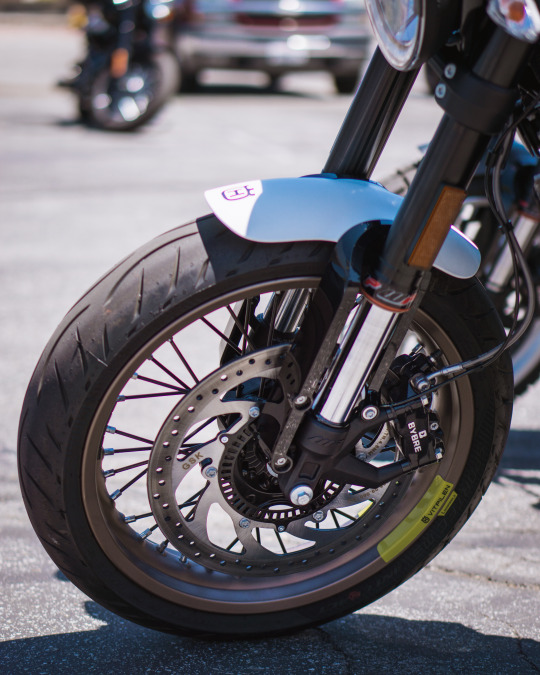
When judging the two models on ergonomics, I kept their natural habitat - urban environments - in mind, as both maintain a fairly sporty position. Starting with the Vitpilen, I immediately noticed the aggressive, forward-leaning stance. Positioning my head directly over the front wheel, the Vitpilen made me want to slalom through mid-day traffic at full throttle. However, that state of mind prooved more enslaving than freeing. After all, I was on a demo tour. If “it’s better to ride a slow bike fast than a fast bike slow,” nothing is worse than living that platitude in reverse. If you’re looking for a nimble, aggressive, lane-splitter, the Vitpilen has you covered, but make sure your journey is manageable, as I already felt the tension in my wrists by the time we returned from the short ride.
On the other hand, the Svartpilen utilizes high-rise bars to position the rider at ease. From the upright posture, I was content to stay in line and putt along at a legally acceptable speed. Sure, I tugged on the throttle from time to time, but the relaxed stance felt more conducive to congested road conditions. If the Vitpilen’s ergonomics equate to a Supersport, the Svartpilen would be it’s Naked/Standard counterpart. Both bikes are aimed at city-dwellers and while it would be a stretch to say that either of them let you stretch your legs out, neither of them feel cramped. Though I’d probably opt for the Svartpilen in most situations, if I were visiting one of the local canyons (GMR, HWY 39, etc), I’d certainly side with the Vitpilen.
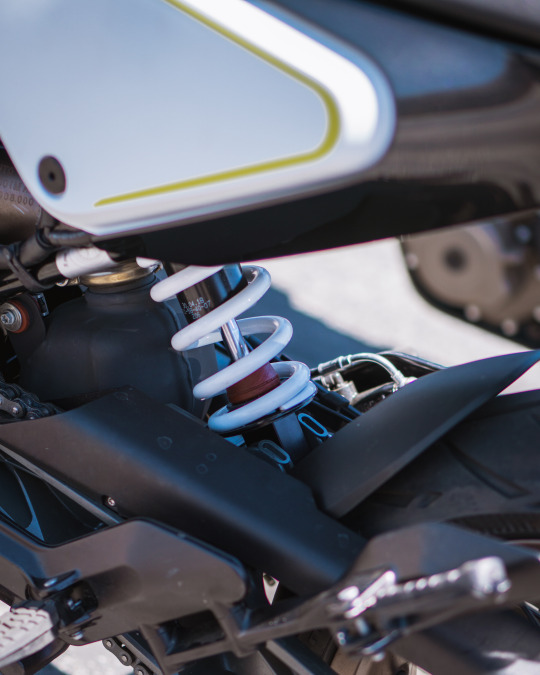
While the ergonomics shift the rider into different postures - and different states of mind - the road manners of the bikes are quite similar. With all models under 6 inches of travel, I could easily flat-foot each bike. Despite its smaller stature, the 401s benefited from the same WP 43mm inverted forks that graced the front end of the 701s. On the road, each bike was compliant and responded immediately to my every input. Particularly, the Vitpilen - with its clip-ons and head-down posture - reacted to every adjustment of my body.
Not only did the suspension allow the bikes to cut from side-to-side, it also made the 401s and 701s feel planted. From soaking up potholes to providing stable steering at speed, KTM’s proprietary suspenders highlighted how fun these machines can be. On the contrary, the lack of suspension travel on the Svartpilen did beg the question: couldn’t this model be much more fun? Aside from ergonomics and a few bits of design (paint mainly), how does the Svarpilen distinguish itself from the Vitpilen?
And that’s where I got to thinking about the lack of sales for these two models. After taking everything into consideration, it seems like Husqvarna’s “Real Street” motorcycles are going through an identity crisis. Are these bikes retro or performance? Can you consider a motorcycle “premium” (as the price would suggest) the dash looks more like a digital alarm clock and it doesn’t come with dual-disc brakes? But maybe it’s less of an identity crisis and more of a false identity. For instance, Husqvarna outfits the Svartpilen with dirt tracker styling yet they can’t endorse taking the low slung machine off-road. Even with the aesthetic hinting at dirt-capabilities, the Svartpilen is essentially a naked bike with knobbies.

Broadcasting a false image can ensnare potential buyers - or it can turn them off (like it did for me). Intoxicated by the snappy acceleration of the 401, I actually looked into purchasing a Svartpilen following the demo. But the lack of off-road capability soon soured my initial enthusiasm. If it can’t hang in the brown, why outfit it with Pirelli Scorpions? Why adopt tracker design cues? What’s the point of making form decision if it’s contrary to the function? That disillusionment made me look at the Svartpilen & Vitpilen differently.
With an MSRP of $6,299 for the 401 and $11,999 for the 701, it’s easy to see why the KTM-owned brand is having problems moving units. Coupled with the unconventional design (which I actually love but can understand how some wouldn’t), Husqvarna has it’s work cut out. Along with the lackluster sales figures of the Svartpilen & Vitpilen, the Real Street Demo stop in Azusa failed to highlight the full capabilities of models. With the near highway miles away, riders were relegated to a jaunt around the block. As a result, I never got the gearbox past 3rd and that doesn’t instill much confidence in potential customers. The combination of disorganization, bikes-to-rider ratio, wait times, and early wrap-up, I’d venture to say that the demo barely moved the needle on these two bikes.
With all that said, if you’re looking for a stylish motorcycle to ride in the city, Husky’s street lineup may be a good option. The brand continues to promote their 0% APR (up to 48 months), so you may score a new Svartpilen or Vitpilen for a great price. For my intents, the bikes are too niche in design and too specialized in purpose, but that doesn’t mean they won’t work for you. I guess the best advice I can give to potential buyers is to test ride as many motorcycles as possible. I know I will be!




Would you ride a Cafe Racer?
Why or why not?
The tach needle bounced off the red line. The motor screeched. My hands clenched the grips. An 18-wheeler barreled by with a gust of displaced air, pushing the bike - and me - to the side of the highway.
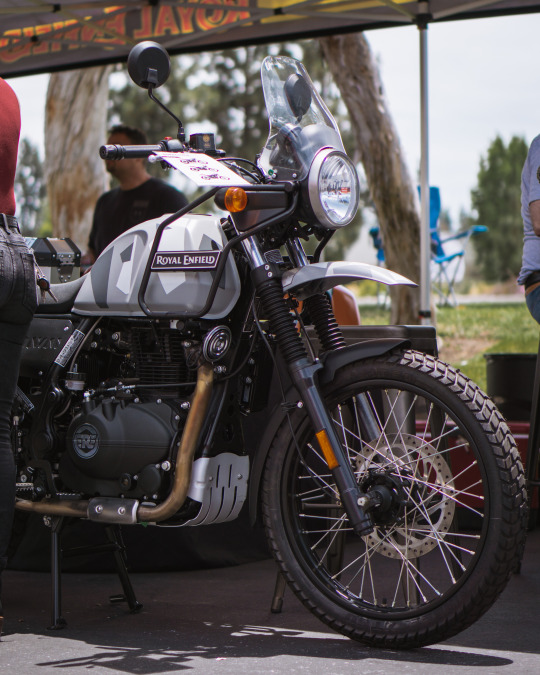
In my quest to find the perfect second motorcycle, I’ve rented an FZ-07. I’ve test ridden Zero’s naked bike, the SR/F, and demoed their dual-sport, the FX. While all of those bikes were great in their own respects, none of them met my criteria: light, dirt-capable, and cheap. So when I heard that Royal Enfield was launching a nationwide tour featuring some of their newest models, I knew there was strong potential to find my scrambling side piece.
Titled Pick Your Play, Royal Enfield’s demo ride event brought me to the highly revered Southern California Motorcycles in Orange County, CA. If you should know anything about Royal Enfield, it’s that the Indian company relies on classic styling with no-frills engineering. You won’t find traction control or TFT displays on their motorcycles. Liquid-cooling and heated grips aren’t featured on any Royals. Shoot, most of the models don’t even have gear indicators.
It’s this unabashed appeal to the “purist” that differentiates the brand from its competitors while keeping their prices low and their “cool” factor high. However, harkening back to yesteryear not only attracts hipsters it also attracts the riders that were around for the original Cafe-styled bikes: old dudes! And if you’re looking to attract aging gentlemen, you’d be smart to host your demo rides in the bastion of affluent retirees - The OC.
Aside from the 3-4 participants that were in my age group, I’d estimate that the majority of the attendees were collecting Social Security. Let’s just say that there was an abundance of high-viz gear and modular helmets. One of my favorite guys was even sporting a shirt with the term “Air-cooled” emblazoned across the chest. Now, please don’t read any of the previous statements as ageism. I LOVE old dude shit (I mean, I ride a Harley). I only point out the age discrepancy because Royal Enfield specifically cast the spotlight on the INT 650 and GT 650 for the Pick Your Play event, two models aimed at a younger rider.
Though attendance was strong, I’m not sure if Royal Enfield expected this turn out when they pushed off on their 8-city tour. To the company, these retro-cool, city-dwelling models cater to a younger demographic. If I can’t convince you of that fact, maybe the event flyer can…

With all of that in mind, when I approached the sign-in desk to reserve my first demo ride, I did the most “old dude” thing possible, I asked to test out Royal Enfield’s adventure bike: the Himalayan.
The Himalayan was dirt-capable. Check! The Himalayan was light (well, lighter than my Harley). Check! The Himalayan was cheap. Check! So when I threw my leg over the 31.5 inch-high seat, I couldn’t help but have high hopes for Royal’s compact off-roader.
As the instructor hollered liability terms and the obligatory sales pitch, I looked over the bike. The simplistic, classic lines spoke to my minimalist preferences. The lack of gadgets and rider aids made the model feel immediately approachable.

With its metal tank, bare-bones instrument cluster, and halogen headlight, the vintage-styled dual-sport looks like it could have been a contestant in the original Dakar Rally of ‘79. Based on looks alone, it would be understandable if you confused the Himalayan for BMW’s iconic R80G/S. But Royal Enfield isn’t sharing market space with Beemer’s first GS, it’s up against a much more advanced generation.
Unlike the leader of the adventure class, BMW’s R 1250 GS, the Himalayan doesn’t boast a navigation system with Bluetooth connectivity, you won’t find a quick-shifter on it, there isn’t an Electronic Suspension Adjustment system, it doesn’t need Hill Start Control (does anybody?). But also unlike the GS, Royal’s ADV isn’t ugly as sin, and that may be the bikes biggest appeal, its aesthetics.
From the exposed sub-frame to the fork gaiters, from the skid plate to the ‘HIMALAYAN’ branded side panels, from the cafe-esque gas tank to the aluminum panniers, Royal Enfield’s thumper is easy on the eyes (as far as adventure bikes go…). The single-cylinder engine, tank guard, and high front fender complete a very tasteful package. But once I finished ogling the thing, I wondered to myself, ‘would function live up to form?’
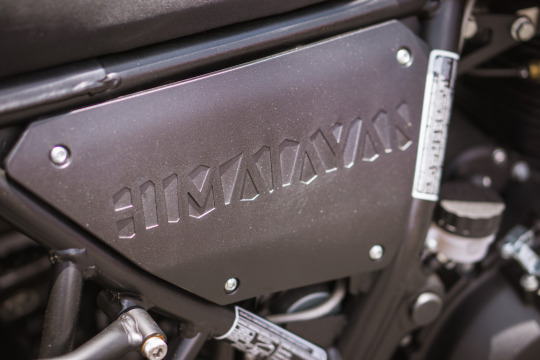
I settled into the ultra-comfortable seat, grasped the handlebars, and retracted the kickstand. With my right boot resting on the peg, I jammed the shifter into first gear, revved the engine, and slowly released the clutch. To my surprise, the friction zone didn’t engage until I was about 3 quarters of the way out. I’m sure this was a result of tens of thousands of miles racked up on a nationwide demo tour, but it certainly brought back a long lost feeling, as memories of stalling out flashed before my eyes. I thought of the time I bogged the engined and dropped the bike in an intersection. I cringed as the sound of honking horns came rushing back. Thankfully the power kicked in just in time, relieving me of that dreaded “novice” embarrassment (especially in front of these seasoned riders).
Once I got up to speed, I repositioned my feet, a necessary adjustment on the Himalayan. With the pegs residing directly under the rider and the pedals at a level angle, I couldn’t decide whether I wanted to scoot fore or aft on the saddle. I eventually sided with a forward-leaning posture, but that left me feeling as if I was mounting a rocking horse.
Luckily, I was able to work myself into a passable position as we approached our first light. At a slow roll and with the relatively low seat height (for an ADV), I could duck walk the bike, a comforting attribute when you’re new to adventure riding, even if it makes you feel like a toddler on a pushbike. But it’s when you twist the throttle on the Himalayan that it makes you feel like you’re actually on training wheels.

Touting 25 HP and 20 ft-lb of torque, Royal Enfields little 400 felt like it was running through mud, despite the fact that we were rolling over fresh pavement. Though I didn’t record the time any of my 0-60 mph pulls on the single-cylinder scoot, the combination of the stocky frame and the anemic motor allows me to comfortably hypothesize that it was well into the double digits (in seconds).
The inherent sluggishness of the Himalayan was most evident in one of the worst places possible: the freeway onramp. As the group merged into the congested lanes of Highway 57, I cranked on the throttle. The tach needle bounced off the red line. The motor screeched. My hands clenched the grips. An 18-wheeler barreled by with a gust of displaced air, pushing the bike - and me - to the side of the highway.
Luckily our freeway run only lasted a quarter-mile, as the fleet of Royals exited at the very next turnoff. Re-entering the comfortable confines of surface streets allowed me to re-gather my wits and put the Himalayan back where it belonged, on roads with speed limits below 65 mph. At this point in the demo, I saw RE’s little adventurer as a glorified moped with taller suspension and better ergos. It didn’t help that in addition to the unenthused acceleration, the bike didn’t receive any help from the clumsy gearbox.
At only 5-gears, the transmission felt like an accurate reflection of the Himalayan’s $4,499 MSRP. I found myself unintentionally shifting into neutral several times throughout the ride. It was quite amazing that I could find neutral not only during my upshifts but also during downshifts. The problem is, I was trying to find 1st and 2nd, not neutral. On the other hand, I’m grateful that Royal Enfield outfitted the dash with a gear indicator so I could quickly identify any hiccups with the shifting. That feature was certainly handy when I rolled to a stoplight in 3rd gear, but that’s where the bike really performed - while braking.

Though the engine was more worthy of a golf cart, the brakes felt like they came off a Mack Truck. Sporting a 2-piston caliper up front and a single-pot caliper out back, the braking system of the Himalayan may have been the most impressive aspect of the mini-ADV. While the braking components don’t sound powerful on paper, in concert, they performed with a high level of efficiency and effectiveness, bringing the bike to a halt with immediacy. At times, it felt like the braking power was almost too effective, especially given the bike’s suspension.
Fork dive never results in a good feeling, but with such powerful brakes and flimsy 41mm fork legs, the sensation was inevitable on the Himalayan. Coupling two incongruent systems usually highlights the deficiencies of the pairing rather than the benefits of the exceptional component. Yes, the brakes of Royal’s ADV stood out, but the collapsable front suspension only turned that positive into a negative.
At the rear, the monoshock exhibited stiffer, more responsive reactions to braking/acceleration and road irregularities, but the inconsistency of the unit also plagued the ride. For a model that’s supposed to spend a good portion of its life in the dirt, I doubt the combination of the underpowered motor, 420lb+ curb weight, and remedial suspension would be helpful off the pavement. I wouldn’t feel comfortable tackling anything more challenging than a fire road on the Royal. That’s especially sad for a bike named the Himalayan.
On that note, I was relieved that we never rode the bike in the brown. Although you don’t need all the power in the world when you’re riding off-road (in some cases it can be a detriment), you do need to be able to get yourself out of tight spots and over obstacles, two things that seemed daunting to me while riding atop the overweight/underpowered ADV.

The sub-500cc dual-sport market is dominated by motocross-inspired machines originally designed in the ‘90s (& unchanged since) and the Himalayan is a breath of fresh air - even if its design plays on a past era. With retro styling and fuel injection, it’s ironic to say that the Royal Enfield is enlivening the segment. But with most of the models in the category approaching 3 decades of continuous production, it’s nice to see someone trying something different. Even if the dual-sport consumer focuses more on specs than looks, the Himalayan may attract an audience due to the simple fact that it is different.
For me, I don’t think the concessions made in function are worth the nominal boost in form. Weight to power ratios reign supreme in the dual-sport world and RE’s thumper resides at the losing end of both spectrums. Weighing in with the 600s and generating the power of a 250, the only saving grace for the Himalayan is its aesthetics and price.
I’m not a rider that needs (or wants) Bluetooth connectivity. I’m happy to go without traction control. However, opting for the “purist” route shouldn’t mean sacrificing the performance of the machine. There should be a mean between maximal and minimal, a median between overpriced and underperforming, a middle ground of handsome and hideous. If BMW’s R 1200 GS is the thesis of the Adventure market, the Himalayan is the antithesis, and what I’m looking for is the synthesis of those two ideas.
With that, my search for a perfect second bike will continue. What I thought was an easy feat, seems to be more elusive than I anticipated. Along with light, dirt-capable, and cheap, I’ll need to add a few other attributes to my criteria, and of course, that means I’ll have to test out more motorcycles…
Poor me ;)
